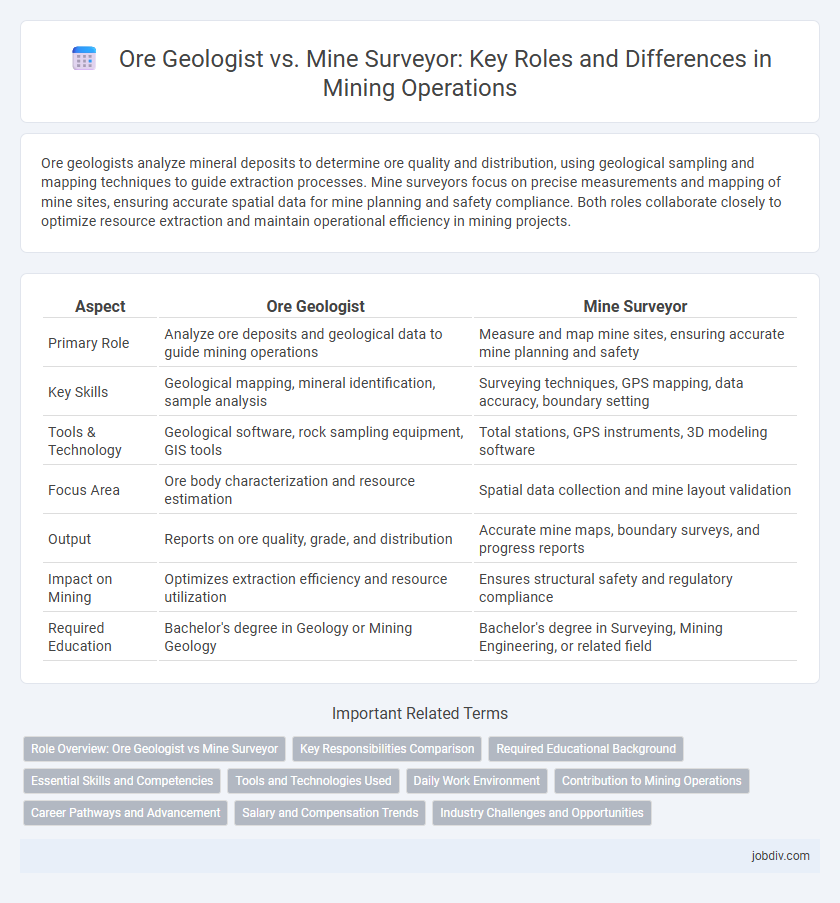Ore geologists analyze mineral deposits to determine ore quality and distribution, using geological sampling and mapping techniques to guide extraction processes. Mine surveyors focus on precise measurements and mapping of mine sites, ensuring accurate spatial data for mine planning and safety compliance. Both roles collaborate closely to optimize resource extraction and maintain operational efficiency in mining projects.
Table of Comparison
| Aspect | Ore Geologist | Mine Surveyor |
|---|---|---|
| Primary Role | Analyze ore deposits and geological data to guide mining operations | Measure and map mine sites, ensuring accurate mine planning and safety |
| Key Skills | Geological mapping, mineral identification, sample analysis | Surveying techniques, GPS mapping, data accuracy, boundary setting |
| Tools & Technology | Geological software, rock sampling equipment, GIS tools | Total stations, GPS instruments, 3D modeling software |
| Focus Area | Ore body characterization and resource estimation | Spatial data collection and mine layout validation |
| Output | Reports on ore quality, grade, and distribution | Accurate mine maps, boundary surveys, and progress reports |
| Impact on Mining | Optimizes extraction efficiency and resource utilization | Ensures structural safety and regulatory compliance |
| Required Education | Bachelor's degree in Geology or Mining Geology | Bachelor's degree in Surveying, Mining Engineering, or related field |
Role Overview: Ore Geologist vs Mine Surveyor
Ore geologists specialize in analyzing rock formations and mineral deposits to identify ore quality and quantity, playing a crucial role in resource evaluation and mine planning. Mine surveyors focus on measuring and mapping the mine sites, ensuring accurate spatial data for safe excavation and development activities. Both professionals collaborate closely, with geologists providing geological insights and surveyors delivering precise spatial information to optimize mining operations.
Key Responsibilities Comparison
Ore geologists specialize in analyzing mineral compositions, identifying ore deposits, and providing detailed geological maps to guide mining operations. Mine surveyors focus on measuring and mapping the mine site, ensuring accurate spatial data for excavation, safety compliance, and infrastructure planning. Both roles collaborate closely to optimize resource extraction and maintain operational precision underground and on the surface.
Required Educational Background
Ore geologists typically require a bachelor's degree in geology, earth sciences, or mining engineering, emphasizing mineralogy and ore deposit analysis. Mine surveyors, on the other hand, usually need a degree or diploma in geomatics, land surveying, or mining engineering, with specialized training in topographic mapping and spatial measurement techniques. Both roles demand proficiency in geological software and understanding of mining operations, but their educational focus reflects the distinct technical skills necessary for ore body evaluation versus accurate mine layout and boundary determination.
Essential Skills and Competencies
Ore Geologists require expertise in mineral identification, geological mapping, and data interpretation to evaluate ore deposits and guide extraction strategies. Mine Surveyors must excel in precision measurement, spatial data analysis, and the use of surveying technologies like GPS and total stations to ensure accurate mine layout and safety compliance. Both roles demand strong problem-solving abilities and proficiency in specialized software such as GIS for geologists and CAD for surveyors, emphasizing the importance of technical and analytical competencies in mining operations.
Tools and Technologies Used
Ore geologists utilize advanced geological software such as Leapfrog and Micromine for 3D modeling and resource estimation, alongside hand-held XRF analyzers and core scanners to analyze mineral compositions. Mine surveyors employ precision instruments including total stations, GPS systems, and drone technology for accurate mapping, boundary establishment, and monitoring of mine site progress. Both professions integrate geographic information systems (GIS) for spatial data management, optimizing operational efficiency in mining projects.
Daily Work Environment
Ore Geologists primarily analyze rock samples and geological data onsite or in laboratories to identify mineral deposits and assess ore quality. Mine Surveyors work in the field, using advanced surveying instruments and GPS technology to map mine layouts and ensure accurate measurements for excavation and safety. Both roles require collaboration with mining engineers but differ significantly in their focus: geological analysis versus spatial measurement and mapping.
Contribution to Mining Operations
Ore geologists analyze mineral deposits to determine ore quality and distribution, guiding exploration and extraction strategies that maximize yield and cost efficiency. Mine surveyors provide precise measurements and mapping of the mine layout, ensuring accurate planning, safety compliance, and efficient resource allocation during mining operations. Both roles are essential for optimizing operational workflows and sustaining productive mining activities.
Career Pathways and Advancement
Ore geologists specialize in analyzing mineral deposits to guide exploration and extraction, often progressing to roles such as senior geologist, exploration manager, or technical consultant within mining companies. Mine surveyors focus on measuring and mapping underground and surface mine sites, advancing toward senior surveyor, mine planner, or surveying manager positions. Both career paths offer opportunities for specialization and leadership, with advancement driven by expertise in geological data interpretation or spatial measurement technologies.
Salary and Compensation Trends
Ore geologists typically earn higher salaries than mine surveyors due to their specialized expertise in mineral identification and deposit evaluation, with median annual wages ranging from $70,000 to $95,000. Mine surveyors, essential for ensuring mine layout accuracy and safety compliance, generally receive compensation between $60,000 and $85,000 annually, reflecting their technical responsibilities. Both roles see salary growth influenced by geographic location, company size, and experience, with bonuses and profit-sharing common in resource-rich regions.
Industry Challenges and Opportunities
Ore geologists face the challenge of accurately identifying and characterizing ore deposits, requiring expertise in mineralogy, structural geology, and geostatistics to optimize resource estimation and extraction methods. Mine surveyors encounter difficulties in ensuring precise mapping and spatial data collection within dynamic underground and surface environments, leveraging advanced surveying technologies like LiDAR and GPS for improved mine planning and safety. Opportunities lie in integrating geological data with real-time survey measurements to enhance predictive modeling, operational efficiency, and sustainable mining practices.
Ore Geologist vs Mine Surveyor Infographic

 jobdiv.com
jobdiv.com